Unsure about your French table manners? Click Here to download > > How to avoid these 10 food etiquette mistakes !
- Home ›
- Plan Your France Trip ›
- August in France
How To Survive August In France
(7 Ways To Take Cover)
Published 28 June 2025 by Leyla Alyanak — Parisian by birth, Lyonnaise by adoption, historian by passion
August in France can be daunting, but it can also be fabulous, depending on the choices you make. Here are some tips to choosing destinations that skirt the crowds and avoid (or at least minimize) the heat.
If you’ve ever tried visiting France in August, you may have felt your limits were being tested.
It's hot, and getting hotter by the year. And we don't have much air conditioning.
It's crowded, especially if you're heading to some of our most famous landmarks. Pick your day wrong and you might find yourself stuck on a motorway behind half of Paris heading to the coast.
It may feel like everything is closed for the great France August shutdown, when shop owners are off on their own holidays and cities empty out.
What is open may seem expensive. Often, prices for flights, trains and accommodation go up in summer.
You may be facing strikes. Frankly, though, while summer is a favorite for strikers, by August it's hot enough so that even they lose steam.
What does all this mean? Should you avoid August in France?
Absolutely not!
August can be a wonderful time to visit France.
The sun is out, festivals pop up everywhere, and the long days are an invitation to linger over that last cup of the day in a café.
The key is knowing where to go, avoiding the places where everyone else is already headed, and dodging our ever frequent heatwaves.
Let me show you where to go to escape the heat, how to navigate the crowds, and what kinds of places are best avoided altogether. The goal isn’t just to survive France in August, but to enjoy it in delightful ways.
My top choices for August in France
- 1. Cities that stay (relatively) cool and quiet
- 2. Head for high-altitude villages to beat the heat
- 3. Seek out cooler coasts (and skip the Riviera)
- 4. Head for the hills and hidden wilderness
- 5. Take a boat ride and stay close to the water
- 6. Paddle through France’s wild waterways
- 7. Chill underground: caves and grottoes
- Bonus escape: Step into a church or cathedral
How the French take their holidays
Tips on packing for France in August
NOTE: Pages on this site may contain affiliate links, which support this site. See full Privacy Policy here.
My top choices for August in France
Of course this list is subjective - you'll find plenty of people who rave about Paris or the Riviera in August so you may disagree with me. But as a local who has to "battle" August every year, I've learned a few things about staying cool at the height of the heat.
1. Visit cities that stay (relatively) cool and quiet
Many travelers come for France’s culture and city life — but in August, urban travel can be challenging. The asphalt and cobblestones reflect the heat, many shops are closed, and public transport seems to wind down, with infrequent schedules and curtailed routes (the exception is in highly touristed cities, of course).
That said, there are plenty of smaller cities in France that are cooler in August, and where you won't bump into everyone else visiting France.
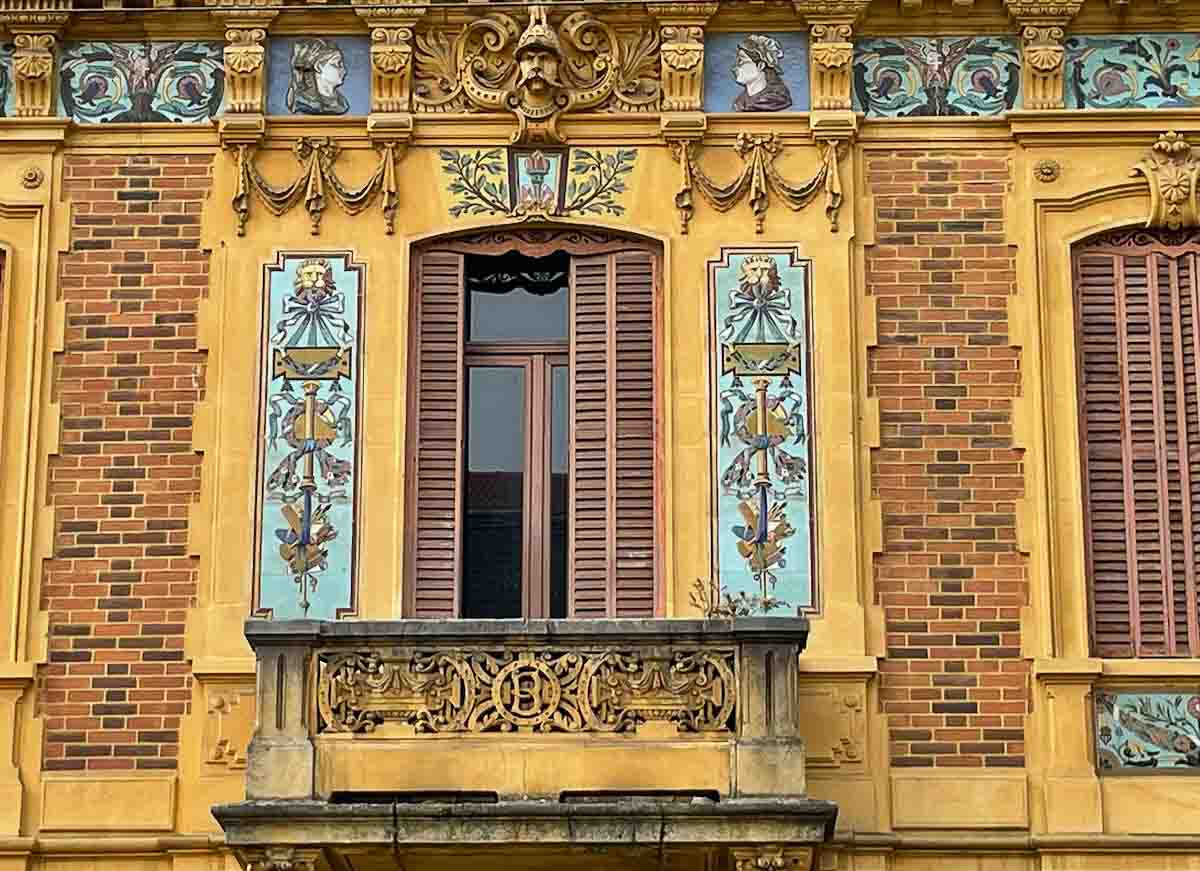 An Art Nouveau building façade in Nancy ©OffbeatFrance
An Art Nouveau building façade in Nancy ©OffbeatFrance- Nancy: The former capital of the Duchy of Lorraine is best known for its stunning Art Nouveau and 18th-century architecture. At its heart, the UNESCO-listed Place Stanislas is one of France’s grandest squares. The city's average August day temperature is 25℃/77℉, with cooler nights and far fewer tourists than other cities its size.
- Besançon: Located on a bend of the Doubs River and surrounded by greenery, Besançon enjoys natural shade that cuts back some of the heat of summer. Worth seeing is the 17th-century Citadel, designed by Louis XIV’s military engineer, Vauban, and part of a UNESCO-listed network of fortifications across France.
- Clermont-Ferrand: A central French city built from volcanic stone. Cafés, markets and landmarks like the Romanesque Notre-Dame-du-Port remain open, with fewer visitors than in larger urban centers.
- Pau: Its setting at the edge of the Pyrenees (amazing views!) provides the city with cooler air and mountain breezes. Museums and markets remain open, and the town’s compact size makes it easy to explore on foot. It also happens to be the birthplace of Henri IV of France, for those of you who are historically inclined.
- Aurillac: At 600 meters above sea level, Aurillac remains cooler than many cities. It’s quiet most of the month, but hosts one of Europe's largest international street theater festivals in late August.
- Briançon: This is France’s highest city at 1,326 m, so you can look forward to crisp mountain air, and historic UNESCO fortifications by Vauban (he's everywhere!).
2. Head for high-altitude villages to beat the heat
Some villages avoid the worst of summer simply by being above the heat. These towns stay cooler thanks to their elevation and shade from nearby peaks. They're not empty — many are beloved summer getaways — but they're far more pleasant than the baking lowlands.
These mountain towns offer reliably cooler summer conditions — often with daytime highs under 25 °C (77℉) — and remain welcoming even during August heatwaves.
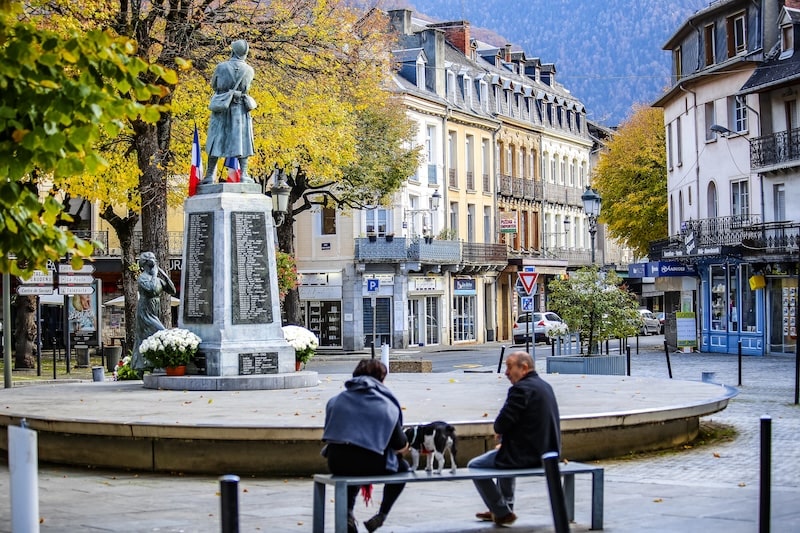 Luchon, France
Luchon, France- Le Mont‑Dore: A volcanic spa town in the Auvergne at an altitude of around 1050 m/3300 ft, cooled by surrounding volcanic peaks and pine forests.
- Luchon: Right in the Pyrenees with thermal baths and Belle Époque charm, and shade provided by high-mountain forests.
- Saint‑Véran: One of Europe’s highest villages at over 2000 m/6600 ft, with alpine scenery, with temperatures consistently near 20 °C, even in summer.
- Samoëns: At 700-800 m in Haute‑Savoie, just down the road from me on the way to Chamonix, this pleasant stone village in the Alps has milder summer weather, lovely architecture, and easy access to shaded trails.
- Die (pronounced DEE): More town than village, this is the gateway to the Vercors mountains, known for alpine honey and local sparkling wine, and a major stronghold of the Resistance during World War II.
3. Seek out cooler coasts (and skip the Riviera)
Southern beaches are packed in August, with traffic, inflated prices, and hot crowded sands (or pebbles). But head to northern France (or the west), and you’ll find tidal islands with windswept shores, and plenty of space to breathe.
It will still be hot — it is summer, after all — but not as suffocating as many other parts of France. I've listed a few places below but frankly, you could go pretty much anywhere along the Brittany and Normandy coasts and feel a bit cooler than you would elsewhere in coastal France.
 Ile de Bréhat
Ile de Bréhat- Western Normandy – The small fishing village of Barfleur is absolutely adorable, with its colorful fishing boats dotting the harbor (it is often called one of the most beautiful in France), and it’s rarely overrun. Granville, perched on a cliff with views to the Channel Islands, has both beaches and culture (and the Christian Dior Museum). Finally, Carteret's wide beaches and dunes are matched only by its seafood.
- The Vendée coast – Much calmer than southern France, this stretch includes spots like Saint-Gilles-Croix-de-Vie, a lively seaside town with long beaches and shaded market streets. Or try Île de Noirmoutier, a tidal island with pine forests, salt marshes, and sea air to spare.
- Northern Brittany – Places like Cancale, world-renowned for its oysters and lined with wild coastlines, or the historic port town of Roscoff, stay breezy even in August. For something quieter, head to Île-de-Bréhat, where cars are banned and walking paths hug the rocky shore.
4. Head for the hills and hidden wilderness
France is a very mountainous country, from the Alps and the Jura to the Vosges, the Pyrenees and the Cevennes.
While the highest peaks can get crowded in summer, the mid-range mountains often stay cool and quieter, not to mention more affordable. And yes, you'll find plenty of lovely stone villages tucked away among the greenery.
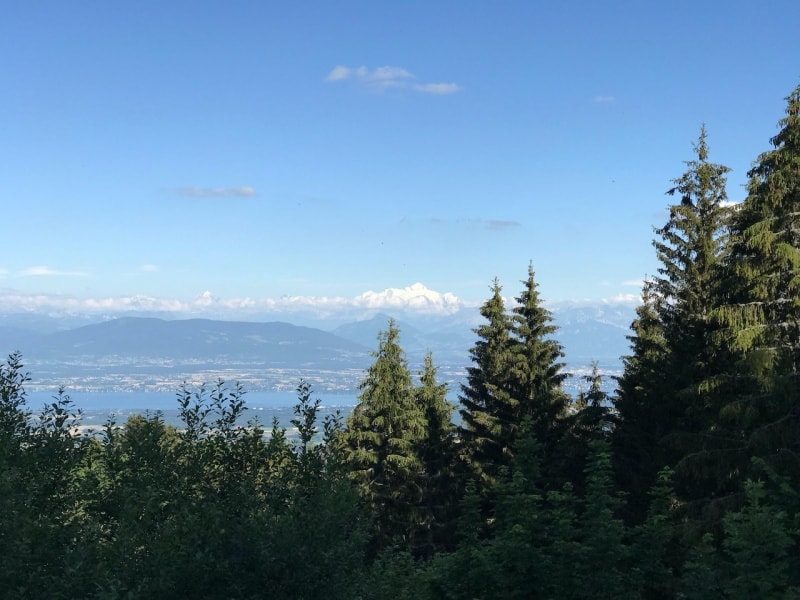 I took this photo from the Jura Mountains looking out to Lake Geneva and the Alps beyond ©OffbeatFrance
I took this photo from the Jura Mountains looking out to Lake Geneva and the Alps beyond ©OffbeatFrance- The Jura (I'm very partial — this is where I live!) near the Swiss border is cool and fun in August. The mountains are criss-crossed with hiking trails and waterfalls. It's also the ideal season for cheese: this is the home of Comté, France's favorite. Visit some lovely stone villages, like Baume-les-Messieurs, sample the Jura vin jaune, "yellow wine", or swim in lakes like Chalain or Vouglans.
- The Vosges Mountains just south of Alsace are an alternative to the Jura. Gérardmer and La Bresse feel almost alpine but without the steep prices or crowds. The region is dotted with glacial lakes, like Lac de Gérardmer, and you can hike through pine forests once used by resistance fighters. Here too, local farms open for cheese tastings.
- The Massif Central — This ancient volcanic region is cooler and less traveled than the Alps, with crater lakes like Lac Pavin and high-altitude spa towns like Le Mont-Dore. Villages like Saint-Nectaire have Romanesque churches and thermal springs, and local markets are loaded with mountain cheeses and charcuterie. Hiking trails wind through extinct volcanoes, past pastures and panoramic viewpoints which are rarely overrun by tourists.
- The Aubrac and Cévennes are high plateaus between Lyon and Montpellier that stay relatively cool in summer. If you're a long-distance hiker craving solitude and sweeping views, the Stevenson Trail (GR70) crosses both regions, with shorter local walks passing through Romanesque chapels (yes, it's a weakness), stone hamlets, pastures and chestnut forests.
- Mercantour and Écrins national parks – If you’re after higher altitudes but fewer people than Chamonix, try these alpine parks for wild valleys and glacial streams. Oh, and you'll be bound to spot an ibex or two.
5. Take a boat ride and stay close to the water
When the heat becomes overwhelming, water offers instant relief, not just for swimming, but also for sightseeing.
Whether you hop on a river cruise, a ferry crossing or a shaded canal barge, being on the water can bring welcome breezes and a fresh perspective, even at the height of summer. Here are ideas for short, accessible trips that require no effort and give you a chance to stay cool and take in the view.
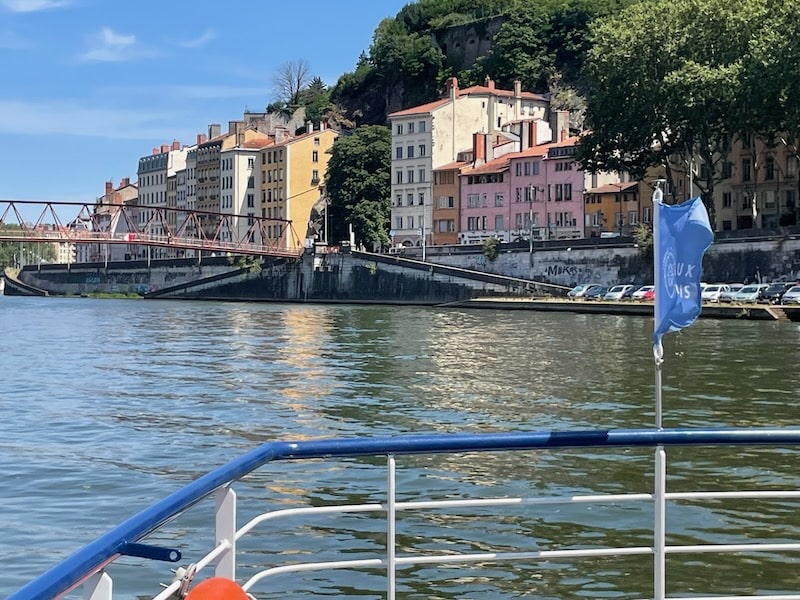 Enjoying a summer sail along the Saône River in Lyon ©OffbeatFrance
Enjoying a summer sail along the Saône River in Lyon ©OffbeatFrance- Lyon: Board a boat on the Saône River for a slow drift through the city. Evening cruises are ideal, but even in the middle of the day, you'll feel a lot cooler here than walking in the city (Lyon is certainly worth your time — just explore in the evening!)
- Marseille: If you happen to be baking in Marseille in August, catch the ferry to the Château d’If or the Frioul Islands. The breeze picks up once you're off the coast, and the sea spray alone is worth the trip.
- Paris: A Seine cruise offers a different take on the capital’s skyline. Just make sure you choose an open-deck boat and you’ll enjoy a steady wind as you glide between historic bridges and monuments.
- Lot Valley: In Saint-Cirq-Lapopie, traditional flat-bottomed gabares still ply the river. It’s remains one of the most scenic rides in rural France, and cool to boot.
- Canal du Midi: You can hop on a short barge tour from Béziers or Castelnaudary and enjoy the slow place and shaded towpaths, perfect for relaxing in August.
- Everywhere in France: Head for the lake. France has plenty of them, and they usually have at least one and often more beaches.
6. Paddle through France’s wild waterways
If water is the answer to your summer heat woes, then what about heading out on a canoe or kayak to get off the road and into the landscape?
Think breeze, shade, and regular dips in the water, all of which you'll find in scenery that reaches from steep gorges to wide rivers lined with castles.
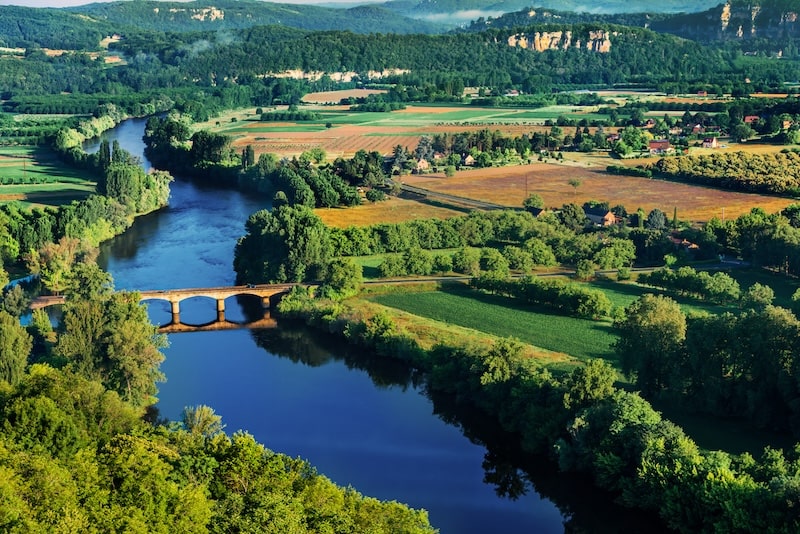 Dordogne River
Dordogne River- Dordogne River: Drift peacefully past hilltop castles and golden villages along lush, wooded banks. If you happen to be in Sarlat-la-Canéda, hop a canoe for added freshness...
- Drôme River: This is one of my favorite regions, often bypassed by tourists heading straight from Paris to Provence. This is one of the country’s last untamed waterways and flows through lavender fields, stone villages, and the foothills of the Vercors. You can book canoe and kayak trips (all levels) from Saillans and Aouste-sur-Sye and enjoy the freshness of early morning.
- Verdon Gorges: Granted, this is a popular area and can get very crowded in summer — unless you head out early in the morning to kayak or canoe through the narrow turquoise canyons in one of France’s most iconic landscapes. The same goes for the Ardèche River — glorious scenery, cool temperatures, but very crowded.
- Tarn Gorges: These are less crowded than the Verdon or the Ardèche, with deep green waters rimmed by towering cliffs. Stop for a shady picnic along the way and float by medieval villages perched above the river. If it gets really hot, stop for a swim.
7. Chill underground in caves and grottoes
The best-kept secret in escaping the summer heat in France is to head for one of its prehistoric caves — or, just any cave.
France is full of limestone caves and prehistoric grottoes where the temperature hovers around 12-14°C, no matter how hot it gets outside. In fact, these underground caves are so cool you'll actually need a sweater. Lovely thought in summer, don't you think?
While there are a few in the north of France, the vast majority of these are in the country's southern half. Some require a short hike, others are fully equipped with visitor centers and guided tours. Here are a few standouts:
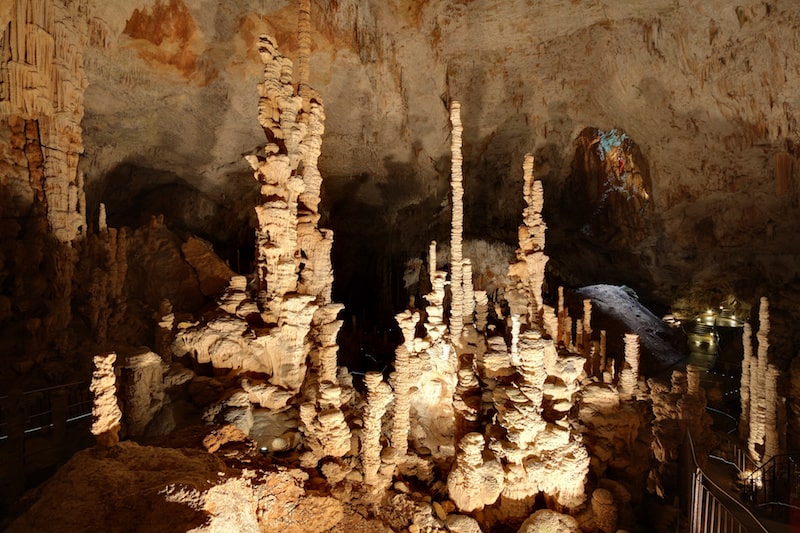 Aven d'Orgnac
Aven d'Orgnac- Gouffre de Padirac (Lot): Enter through a massive sinkhole and head downwards over 100 m for a riverboat excursion inside the chasm. Temperature stays at a consistent 13 °C with high humidity.
- Aven Armand (Lozère): Located in the Cévennes, it features a “forest” of more than 400 stalagmites, including the world’s tallest at nearly 30 m.
- Aven d’Orgnac (Ardèche): This one is prized for its large caverns and has a museum dedicated to regional prehistory. Guided visits run year-round and it also happens to be one of the most scientifically significant caves in France.
- Grotte de Choranche (Vercors): Temperatures hover at a deliciously chilly 10 °C year-round. The cave is famous for its delicate micro-stalactites and internal lakes with olm species (aquatic salamanders, also known as baby dragons).
- Grotte de la Cocalière (Gard): One of France’s most picturesque caves, with a 1 km network, constant 14 °C interior, calcite pearls, and guided visits including a return train through the karst plateau.
Bonus escape: Step into a church or cathedral
Churches and cathedrals are some of the coolest public buildings in France — in every way.
They are usually built of thick stone walls and soaring ceilings, keeping temperatures far cooler than it is outside.
Whether you’re escaping the midday sun or admiring a medieval fresco, these spaces offer silence and a chance to pause respectfully in the shade. And they’re everywhere, from small Romanesque chapels in villages to Gothic cathedrals in major cities, often open and free to enter. Here are just a few:
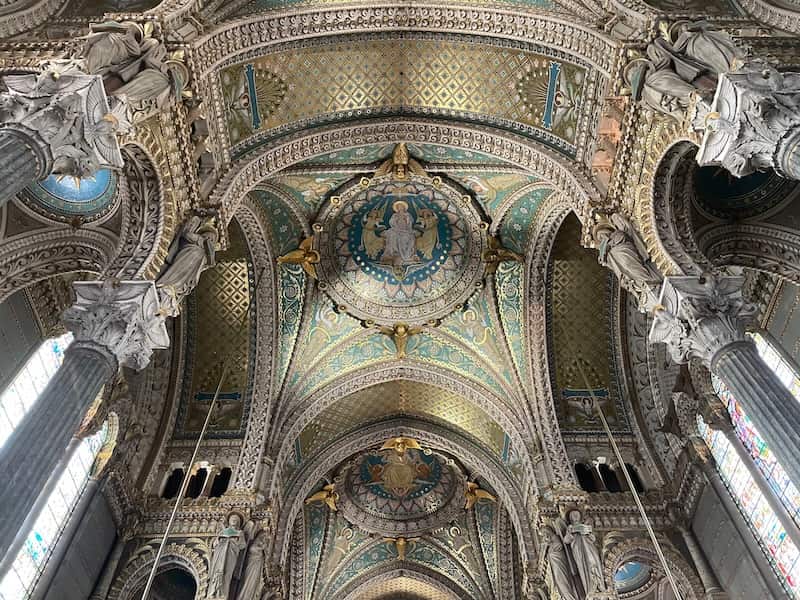 Ceiling of the Fourvière Basilica in Lyon ©OffbeatFrance
Ceiling of the Fourvière Basilica in Lyon ©OffbeatFrance- Basilique Notre-Dame de Fourvière in Lyon is high above the city. It is relatively new (19th century) and is kept cool by its walls and mosaics. This stunning building is a welcome respite from the August heat in Lyon (ride the funicular to reach it).
- Basilique Sainte-Marie-Madeleine in Vézelay (Burgundy) is a Romanesque masterpiece that also happens to be a UNESCO World Heritage site. It's a key stop along the Way of Saint James.
- Cathédrale Notre-Dame de Rouen has a dim, cavernous interior, a cool sanctuary in the summer heat but also filled with historical richness. Not only did Monet paint it umpteen times, but it also happens to be where Richard the Lionheart’s heart is buried.
- Notre-Dame de Chartres (Eure-et-Loir), one of the great masterpieces of Gothic architecture, is known for its deep-blue stained glass and its labyrinth. While you can cool down inside during the day, at night the light show on its façade is spectacular. Of course, by then it's cool outside...
- Basilique Saint-Sernin, Toulouse (Haute-Garonne), is one of the largest Romanesque buildings in Europe. Its heavy stone construction and huge interior spaces keep it naturally cool while you explore the relics of early Christian saints and the intricately carved capitals (tops of columns).
How the French take their holidays
Many visitors are caught off guard by the rhythms of French life in August.
The first two weeks, from around August 1 to 15, is summer break in France, when half the country goes on holiday. This isn’t just a Parisian exodus: small-town restaurants, boulangeries, pharmacies, even tobacco shops may close for congés annuels.
It used to be perfectly possible to walk into a village and not find a place to eat lunch. These days, things have improved slightly and during the holiday season, shops and eateries often stagger themselves so that you won't be left standing. Often, but not always.
If you expect full service everywhere, you may be surprised, so make sure you're prepared.
- Call ahead for restaurants and better yet, reserve.
- Prepare to be flexible if your favorite bakery is shut.
- If the streets are quieter than usual, it's because the French are at the beach.
- Avoid peak travel weekends (especially around the first and third weekends of August).
It reminds me of the month of May, during which much of France shuts down because of its three or four long weekends. The entire country changes its pace as people head off on vacations or to their family homes, leaving the city behind. Welcome to the August vacation.
That said, major sights will be open, as will many stores and restaurants in tourist areas, and festivals will be in full swing.
AUGUST WEATHER IN FRANCE
August is one of France’s hottest months, with average highs of 27–30°C (81–86°F) in much of the south and 22–26°C (72–79°F) in the north. Each year, those temperatures creep up.
Coastal areas may be breezy, but inland cities and valleys can feel stifling. Expect occasional heatwaves, especially in the southeast. Rain is rare but not impossible, especially in the mountains. Evenings are often more bearable — perfect for late dinners outdoors.
Tips on packing for France in August
Your vision of France in August may involve sundresses and espadrilles, and you wouldn't be altogether wrong. Or completely right, either.
Much of France stays hot through August, but not all of it. The mountains, the Atlantic coast and inland valleys can deliver cool mornings and evenings or sudden storms.
Here are a few tips of what to include in your August wardrobe for France:
- A light sweater or jacket, especially if you’re heading to Brittany, the Jura or anywhere near the Massif Central. Temperatures drop quickly after sundown, and it’s not unusual to need layers even in the height of summer.
- Sturdy shoes, if you're headed to the crater hikes in Auvergne or the cobbled streets in medieval towns (don't think you can get away with flip-flops!) You’ll want grip, support, and preferably waterproofing if showers roll in.
- A long-sleeved shirt or two to protect yourself from biting insects in the evening, particularly in rural or riverside areas popular with mosquitoes.
Bottom line, France is a country of microclimates, so keep that in mind when you pack
Where NOT to go in France in August
You’ve now seen some of the best places to escape the August heat and holiday crowds.
But what about the destinations that are less relaxed this time of year?
Some places in France are undeniably beautiful in August… but they may come with long lines, high prices and very little shade.
Mind you, the list below is utterly subjective. Plenty of people visit these places in August and love them. You might too.
The French Riviera and southern France
I'm not a fan of the Côte d'Azur in August.
It's visually dazzling, with cloudless skies, open-air markets and that classic Mediterranean glow.
But you won’t be enjoying it all alone.
This is France’s busiest stretch of coastline, and in August, the roads can feel like one giant parking lot (the real parking lots are scarce and exorbitant). Beaches are super crowded and hotel prices soar. You'll have to reserve to eat out, so forget about being spontaneous.
Once you're away from the sea, it can be sweltering, and don't expect to find air conditioning everywhere.
There are exceptions though, quieter spots where crowds are human-sized, like Villefranche or Cap Ferrat, but it's still the Riviera.
That said, if you're looking for a social summer holiday filled with late nights and bright lights, ignore everything I've just said. But if you're the quieter type, then June or September will provide the same glorious scenery, minus the crowds.
Provence hotspots
It's no secret that I love Provence and the Luberon.
These postcard-perfect villages are wildly popular in summer, and in August, they fill with visitors. Think tour buses, crowded cafés, and long queues for attractions like the Palais des Papes in Avignon or the calanques near Cassis. It’s all still beautiful — but it’s not exactly relaxed.
If you visit, go early in the day and book ahead.
Hilltop villages are deservedly famous and worth visiting, which is what everyone else is doing in August.
Loire Valley châteaux
Places like Chenonceau and Chambord are stunning and I can never visit enough, but in August they're also packed.
Many rooms lack air conditioning, and you'll often find yourself elbow-to-elbow with tour groups.
If castles are high on your list, consider the lesser-known châteaux (like Chinon, for example) or go later in the day when crowds thin and temperatures ease.
If you’re planning for spring or fall, this post provides information to help you choose some of the most legendary Loire châteaux.
Mont-Saint-Michel (especially mid-day)
This iconic island gets very busy in August, especially from before lunch to mid-afternoon, when it's swamped with day-trippers arriving in force by bus. And when I say swamped, I mean "you can barely move" kind of swamped.
The narrow lanes become bottlenecks, and climbing the steps to the abbey can feel like a punishment. If you do go, try early morning or late evening for a quieter, cooler experience (and better light for photos).
It IS one of France’s most iconic sights and is well worth the effort — just maybe not at mid-day in August.
Paris
Paris in August is a paradox.
On one hand, it’s blissfully calm: much of the traffic has gone, and the Seine is just beautiful in the late light (and has now been prepped for swimming).
But if you're after the full Parisian experience — busy cafés and markets, browsing through second-hand books or watching neighbors sipping their apéros — August is a bit more challenging.
Many smaller shops, including boulangeries and local restaurants, close for the month as their owners go off for their own vacations. If you're anywhere near tourist attractions, however, you'll have no trouble finding open places.
For that street life you've come to experience in Paris, you'll be better off before or after the height of summer. But if you're happy with art, architecture, and a quieter, slower Paris, you might actually enjoy it; just bring your patience — and stay cool and hydrated.
Paris is always Paris. August just comes with caveats. Read more here if you’re planning a trip that’s not tied to summer holidays.
Before you go: practical travel tips for keeping cool in August in France
Beyond choosing the right destination, staying cool often comes down to habits and small decisions. A few well-timed choices — where you go, when you move, and how you adapt — can make the difference between wilting and weathering the heat.
Here are some simple, effective ways to take cover when the temperature spikes.
- Visit air-conditioned museums and cinemas. Time your visits for the hottest period of the day.
- Nip into a shopping mall. Cities usually have them right downtown, but even the smallest towns will have malls near the periphery.
- This is the perfect time to refill your food stash in a supermarket or simply to browse in a department store.
- If you're not staying in an air conditioned place, book accommodation with stone walls. The older and thicker the walls, the cooler the room.
- Consider the altitude and making it a factor in where you stay.
- Arm yourself with cooling kit: a humid towel, a portable mini-fan, a real fan...
- Check transport schedules because they often change in summer, and on weekends.
- Shift your schedule: early mornings and late evenings are coolest, so why not spend a few of the hottest hours in the coolest places?
- Or, look for signs that say "Plan d'eau" (pond area) or "base de loisirs" (place of rest or relaxation), which are outdoor venues, often in nature, usually with a small body of water. These aren't for major sport, but they're perfect for a cooling stop along the way.
- Finally, and I've said it before: drink a lot of water!
In case you're wondering about where to go at other times of year, find out the best times to visit France, and where to go, when.
ESSENTIALS FOR FRANCE
WHAT'S THE BEST WAY TO GET AROUND FRANCE?
🚎 If you're in a city, use the excellent public transportation systems.
🚊 If you're going between cities or to smaller towns, you can usually take the train (I buy my tickets through RailEurope or Omio).
🚙 In rural areas, train stations are rarer so you might want to rent a car, which is easy in France (I use Discovercars).
DO I NEED TRAVEL INSURANCE FOR FRANCE?
It depends. If your travel insurance already covers you in France, then you're all set. If not, head for VisitorsCoverage for everything travel.
WHAT ABOUT IDENTITY THEFT AND ONLINE SECURITY?
That's easy! Just get a VPN, which cloaks your online presence (I use NordVPN everywhere).
WILL MY PHONE WORK IN FRANCE? WHAT ABOUT MY CHARGER?
You can use your roaming plan in France. If you don't have one, you can do one of several things (just make sure you have an unlocked phone).
📲 You can order a SIM card before you get to France.
🤳 You can buy a SIM card from a shop in France.
⚡️ You can buy an e-SIM.
WHAT SHOULD I PACK FOR FRANCE?
Here are a few essentials you should NOT leave home without:
👟 Comfortable walking shoes. You'll be on your feet a lot, and... cobblestones.
🔌 Plugs are different in France.
👜 An anti-theft purse (this is the bag I use).
🧣 An infinity scarf, for evenings when you don't want to carry a purse. In Paris and other major cities, there isn't much violent crime but there are plenty of pickpockets.
WHAT'S THE BEST WAY TO BOOK A PLACE TO STAY IN FRANCE?
✓ I use booking.com for my own travels around France. It lists both hotels and apartments, but mostly, it has generous cancellation policies.
Did you enjoy this article? I'd love if you shared it!

